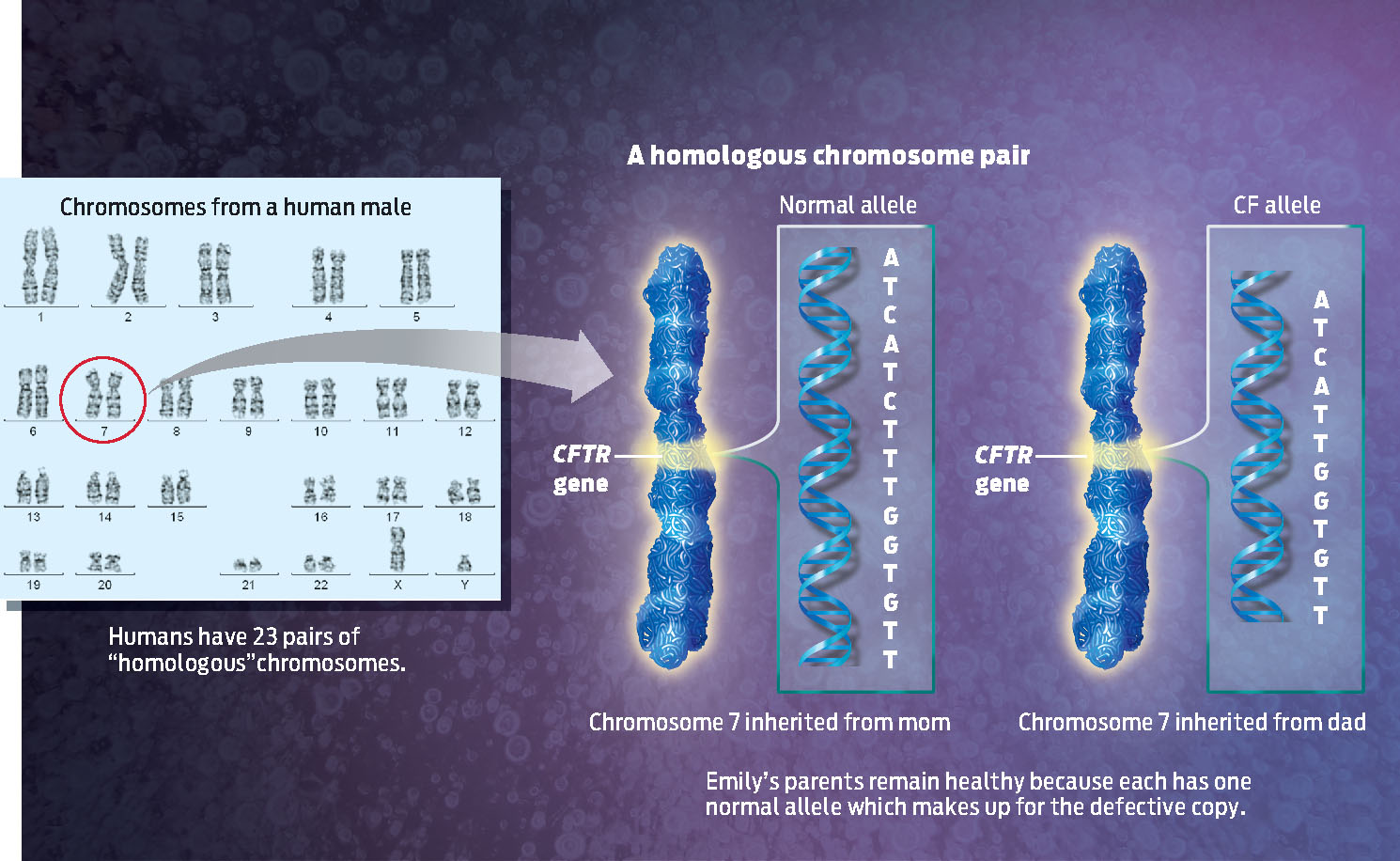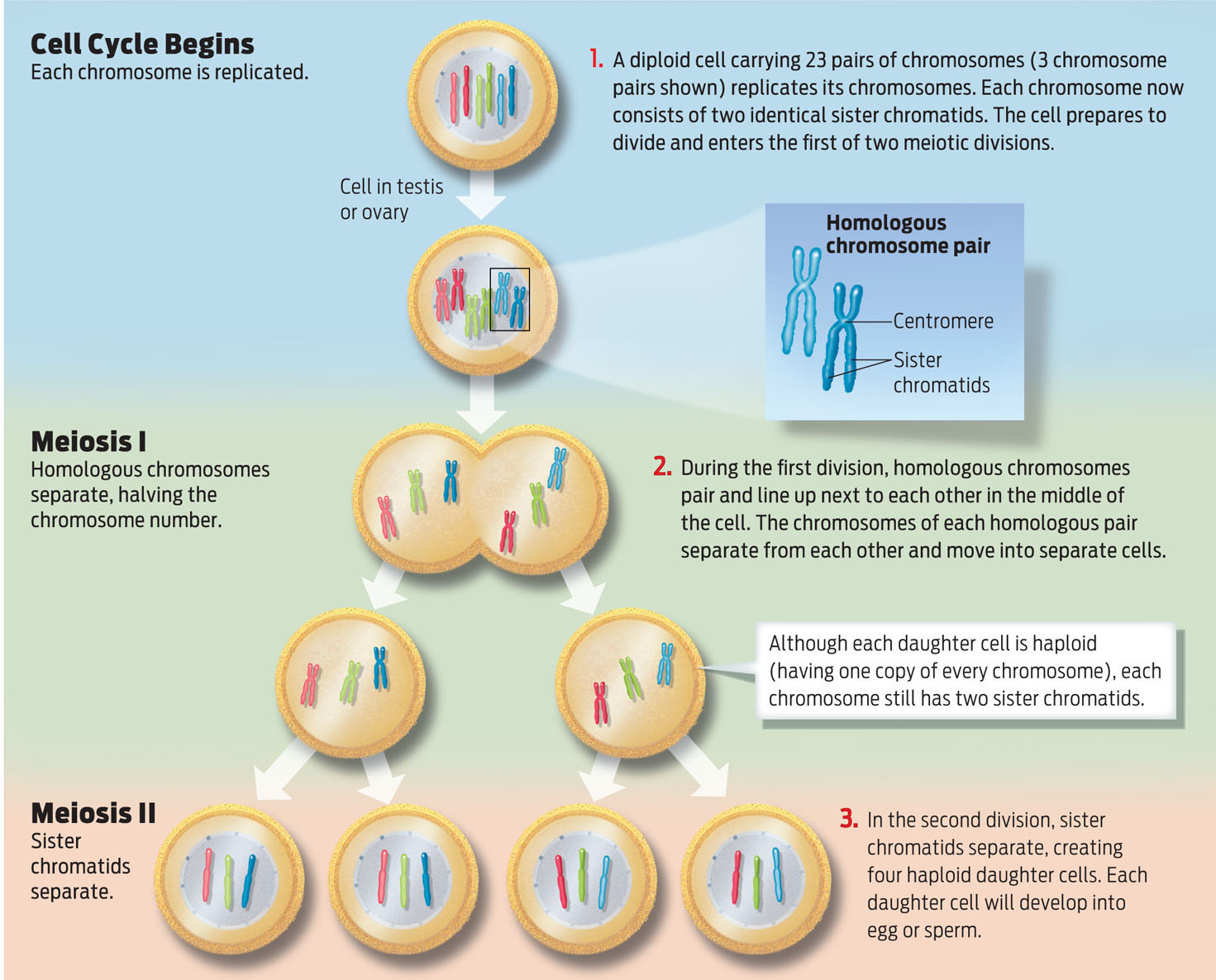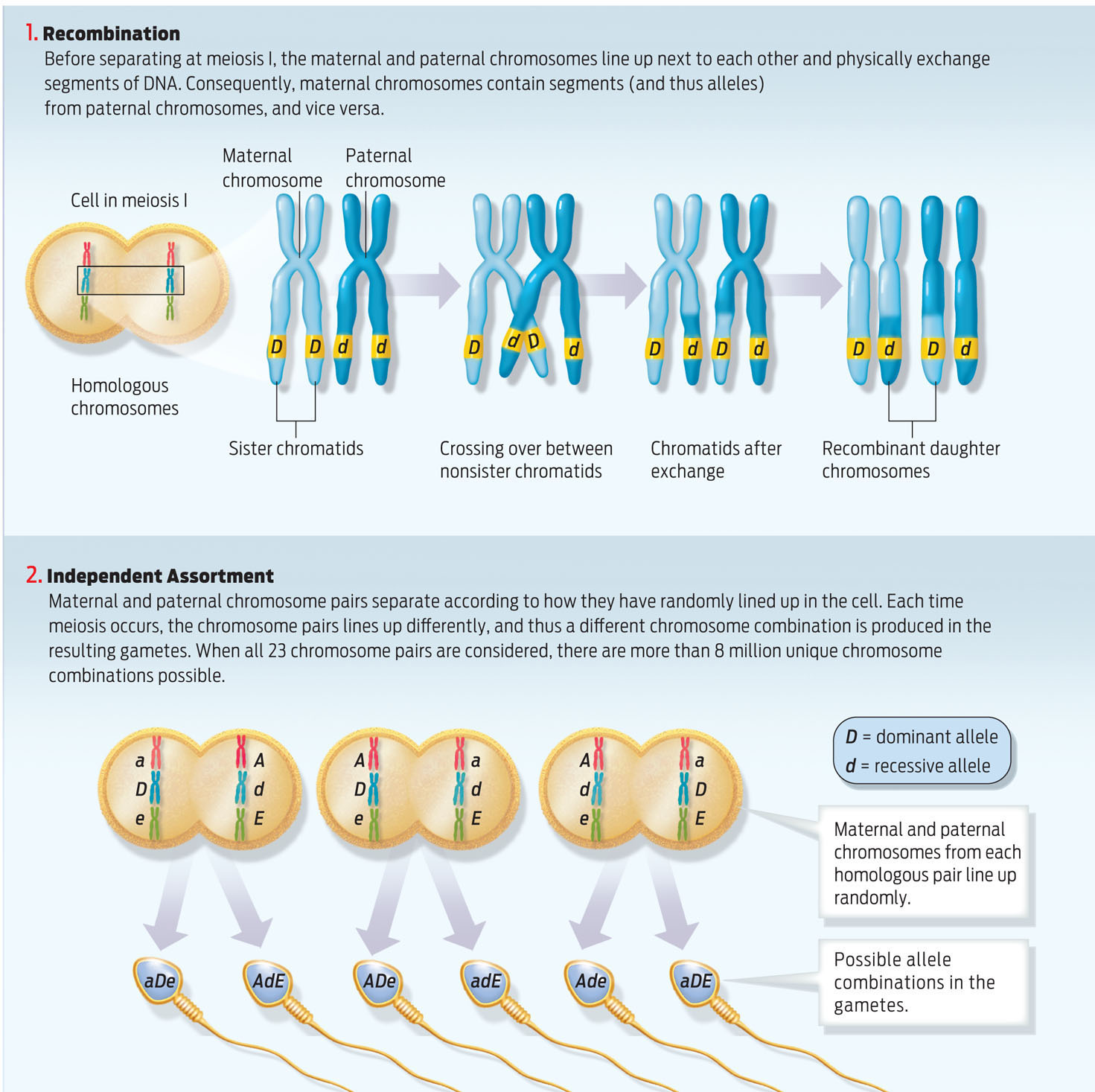HOW IS CF INHERITED?
When Emily’s mother, Debbie, learned that her daughter had CF, she was shocked. She and her husband, Lowell, were both healthy, and they already had two healthy sons. How did their daughter develop a genetic disease that neither Debbie nor her husband had?
DIPLOID Having two copies of every chromosome.
The answer has to do with how genes are inherited—how they are passed down from generation to generation. Genes, which provide instructions for making proteins, are the units of inheritance, physically transmitted from parents to children. The particular alleles of genes you received from your parents are the reason you resemble your mother and father, and possibly also an uncle or a grandparent. But not every child of a couple receives exactly the same set of parental alleles, and so children can and do differ from their parents and from one another.
HOMOLOGOUS CHROMOSOMES A pair of chromosomes that both contain the same genes. In a diploid cell, one chromosome in the pair is inherited from the mother, the other from the father.
Consider Emily’s parents. Like all humans, they are diploid organisms, meaning that each of their body cells carries two copies of each chromosome—one inherited from mom, the other from dad. Such paired chromosomes are called homologous chromosomes. Because chromosomes come in pairs, we have two copies of nearly every gene in our body cells. (Genes located on the X and Y chromosome in males do not have a second copy.) While the two gene copies have the same general function, the nucleotide sequences of the two copies can differ. In other words, a person can carry two different alleles of the same gene, one of which functions differently from the other. In the case of the gene CFTR, a person can have one CF-associated allele and remain healthy if his or her other chromosome has a normal allele to make up for the defective copy. This is why Emily’s parents, Debbie and Lowell, are healthy: they each have one normal allele that masks the defective copy (INFOGRAPHIC 11.2) .
Human cells have 23 pairs of homologous chromosomes. One chromosome of each pair is inherited from mom, one from dad. This makes us diploid, as virtually every cell in the body carries two copies of every gene. The two copies (alleles) can either be identical to each other or different. In the case of CF, carrying at least one normal allele is enough to remain healthy.

PHENOTYPE The visible or measurable features of an individual.
232
GENOTYPE The particular genetic makeup of an individual.
But as Debbie and Lowell also illustrate, it’s not always possible to know what genes a person has just from outward appearance. In fact, geneticists make a distinction between a person’s observable or measurable traits, or phenotype, and his or her genes, or genotype. Both Debbie and Lowell have normal phenotypes, but they both also carry a disease allele as part of their genotype. They each inherited one CF allele from one of their parents and therefore can pass that defective allele along to their children—as they did to Emily.
But not all the Schaller children have the disease—Debbie and Lowell also have two healthy boys. Why didn’t these children inherit CF?
GAMETES Specialized reproductive cells that carry one copy of each chromosome (that is, they are haploid). Sperm are male gametes; eggs are female gametes.
Sexual reproduction is a bit like shuffling the genetic cards. Before parents pass their genes to their offspring, those genes are first mixed up and then the two copies of each gene are separated from each other, so that not every child receives the same combination of alleles. It is the unique combination of maternal and paternal alleles that come together during fertilization that determines a person’s genotype and contributes to his or her phenotype.
HAPLOID Having only one copy of every chromosome.
To reproduce sexually, organisms must first create sex cells called gametes. In humans, these are the egg and sperm cells. Unlike the rest of the body’s cells, which are diploid, gametes carry only one copy of each chromosome, which makes them haploid. To become haploid, the cells that form gametes go through a unique kind of cell division that includes meiosis, which halves the number of chromosomes from 46 to 23. When a haploid sperm fertilizes a haploid egg, the result is a diploid zygote that now carries two copies of every gene on 46 chromosomes. This zygote will divide by mitosis to become an embryo, which will eventually grow into a human child (INFOGRAPHIC 11.3) .
MEIOSIS A specialized type of nuclear division that generates genetically unique haploid gametes.
ZYGOTE A cell that is capable of developing into an adult organism. The zygote is formed when an egg is fertilized by a sperm.
EMBRYO An early stage of development reached when a zygote undergoes cell division to form a multicellular structure.
To reproduce sexually, diploid organisms produce specialized sex cells called gametes, which are haploid-they carry only one copy of each chromosome. When a sperm fertilizes an egg the resulting diploid zygote divides by mitotic cell division, eventually generating enough cells to form a baby. The baby is diploid.

233
Meiotic cell division, which produces haploid sperm and egg, is similar to mitotic cell division (see Chapter 9), except that in meiosis there are two separate divisions. The first division separates homologous chromosomes; the second division separates sister chromatids (INFOGRAPHIC 11.4) .
Humans produce egg and sperm through meiosis, which takes place in the ovaries and the testes. Meiosis halves the chromosome number from 46 to 23.

RECOMBINATION An event in meiosis during which maternal and paternal chromosomes pair and physically exchange DNA segments.
Because it unites haploid egg and sperm from two people, sexual reproduction is the primary reason that children don’t look and behave exactly like one parent in particular; they inherit alleles from both parents and consequently are genetically a combination of the two.
Besides forming haploid sex cells, meiosis contributes to the genetic diversity of offspring in other ways as well. No two gametes produced by the same parent are identical, and that is because of two major events during meiosis that contribute to the huge variation we see among parents, children, and siblings. The first is recombination, in which homologous maternal and paternal chromosomes pair up and physically swap genetic information by exchanging DNA segments. As a result of recombination, also called crossing over, maternal chromosomes actually contain segments (and therefore alleles) from paternal chromosomes and vice versa.
INDEPENDENT ASSORTMENT The principle that alleles of different genes are distributed independently of one another during meiosis.
234
The second vitally important aspect of meiosis is independent assortment, the principle that alleles of different genes are distributed independently of one another, not as a package. (What alleles for hair color you inherit, for example, have no bearing on what alleles for height you inherit.) The physical basis of independent assortment is the random way that maternal and paternal chromosomes are distributed to sex cells in meiosis. During the first division of meiosis (known as meiosis I), maternal and paternal chromosomes line up next to each other along the midline of the cell and segregate into newly forming cells. Because each maternal and paternal chromosome pair can line up in two different ways (sometimes the mother’s chromosome is on the left, sometimes the father’s is), the exact combination of maternal and paternal chromosomes that each sperm or egg inherits differs every time meiosis occurs. In fact, as a result of recombination and independent assortment, no two sperm or egg cells are exactly alike (INFOGRAPHIC 11.5) .
Meiosis produces haploid gametes that are genetically unique. Each egg and sperm has its own distinct combination of alleles. The two events that create this diversity are (1) recombination and (2) independent assortment.

235
236
When meiosis is complete, each gamete has only 23 chromosomes, which are a mixture of maternal and paternal alleles—and this is the reason that not everyone in the Schaller family has CF. Because alleles randomly distribute into each gamete, some of the Schallers’ gametes will carry the CF allele and others will not. If by chance a sperm that carries a CF allele fertilizes an egg that also carries a CF allele, the resulting child will have CF.
After Emily’s cystic fibrosis was diagnosed, both Debbie and Lowell learned that their parents had relatives who had died at a very young age. At the time, the cause of death was thought to be a respiratory illness such as pneumonia. But these relatives most likely had CF, Debbie now thinks; doctors at the time simply did not have the tools to diagnose the disease.
The Schallers now knew that the disease ran in both sides of the family. But they could still not help Emily. “They told us she would only live to be about 12 years old,” Debbie recalls, adding, “We just put ourselves in the hands of medical professionals.”